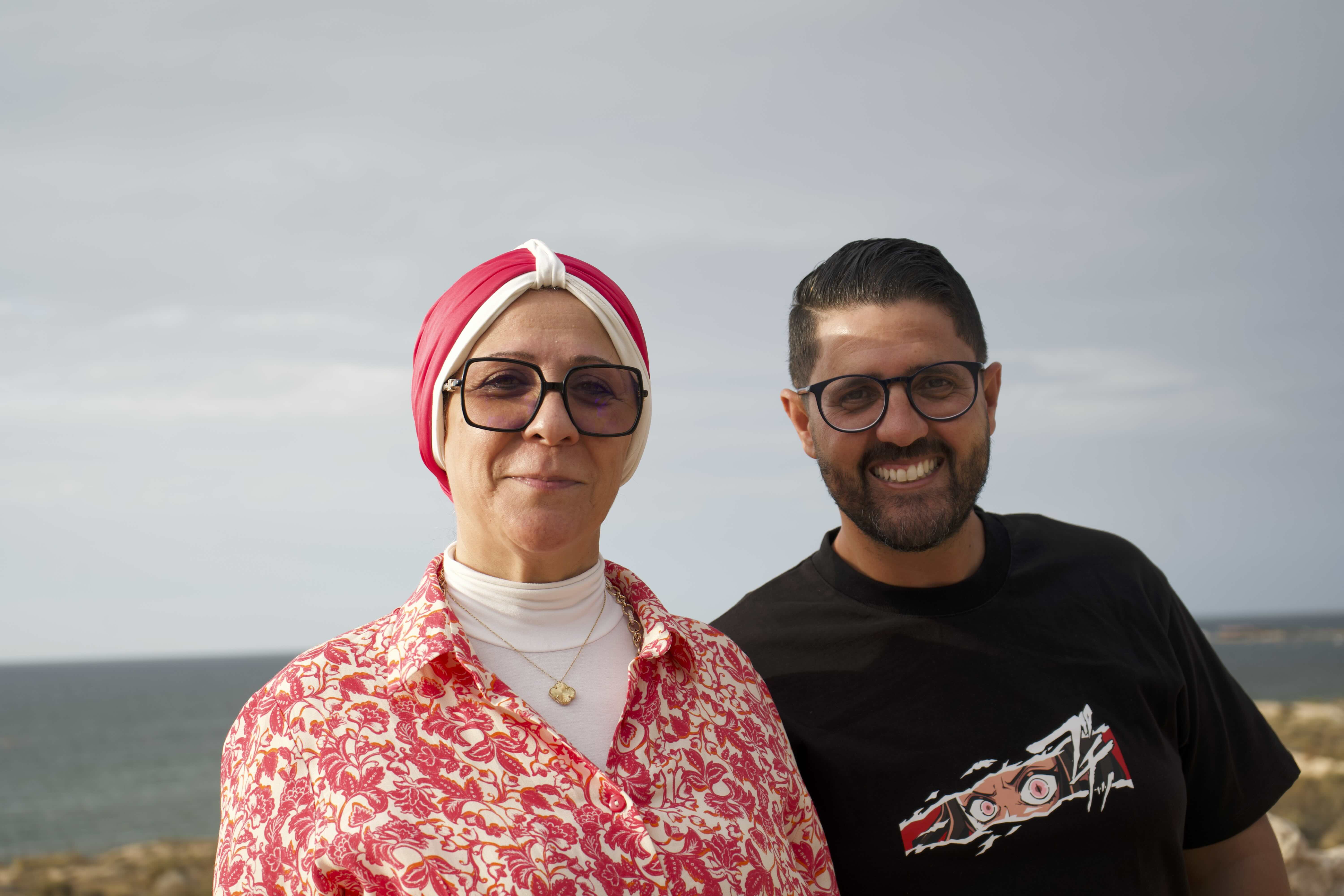Kerkennah Island’s Changing Tides: How a Community is Charting Its Future in the Face of Climate Change

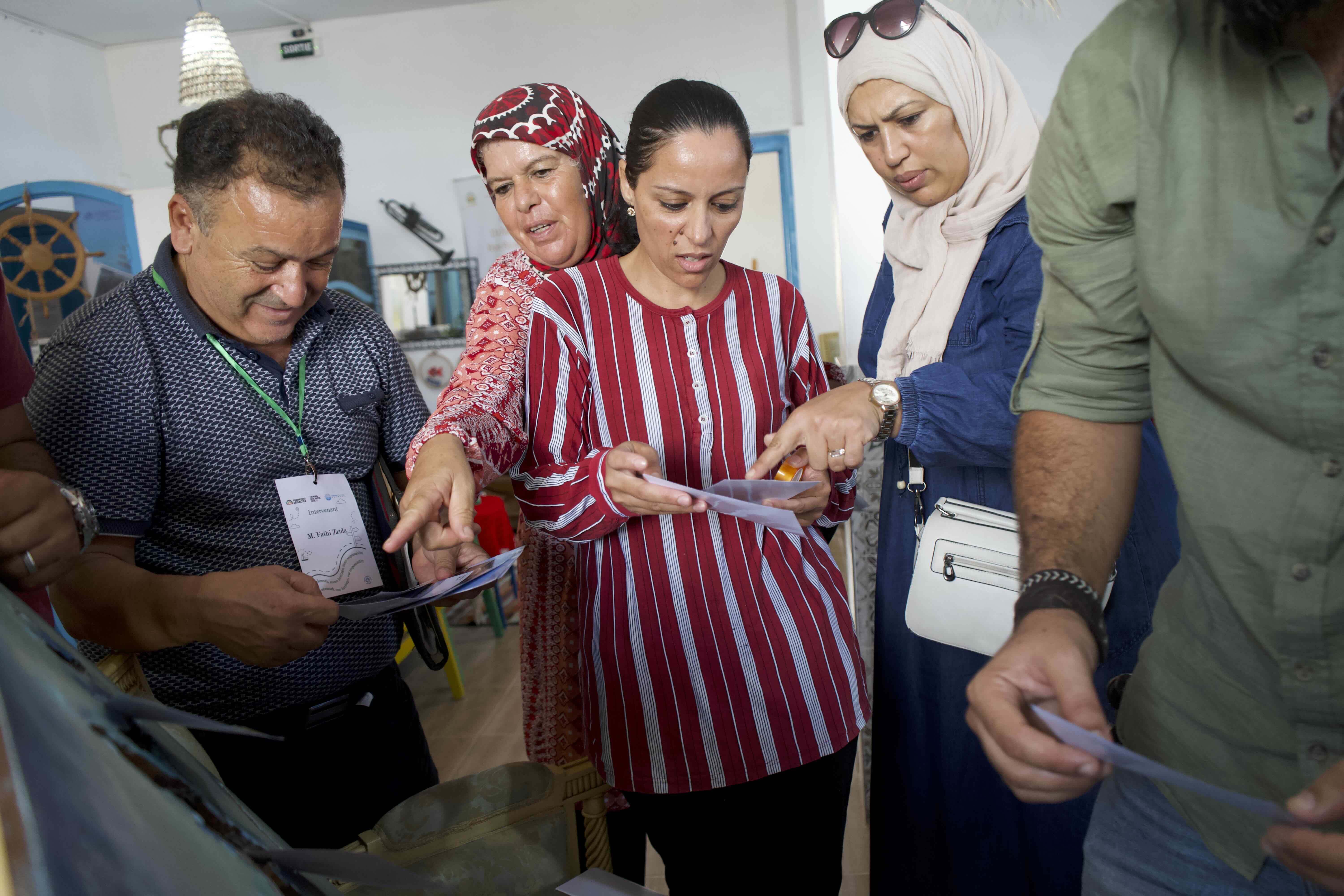
Hear from Dr. Salma Sabour
It is no surprise that the sea is the soul of Kerkennah Island—so calm it often melts into the sky. Only when the sun slips into or rises out of the horizon does the boundary between water and air reveal itself. For centuries, life here has moved with the tides. The island’s ingenious charfia fishing tradition, built from palms once thick throughout the archipelago, embodies this harmony: a system of woven palm traps that channel fish with the currents rather than trapping with nets.

But that balance is unraveling. Rising seas are eating away at the coastline. Saltwater is seeping into the soil, threatening the very palms that sustain charfia and forcing local fishers to experiment with new materials. Salt spray corrodes heritage sites like the stone fort of Borj El Hssar, its layers of Punic, Roman, Byzantine, Islamic, and Ottoman history slowly flaking into the sea. Even the island’s central marabout, long a place of community gathering and prayer, now faces encroaching tides.
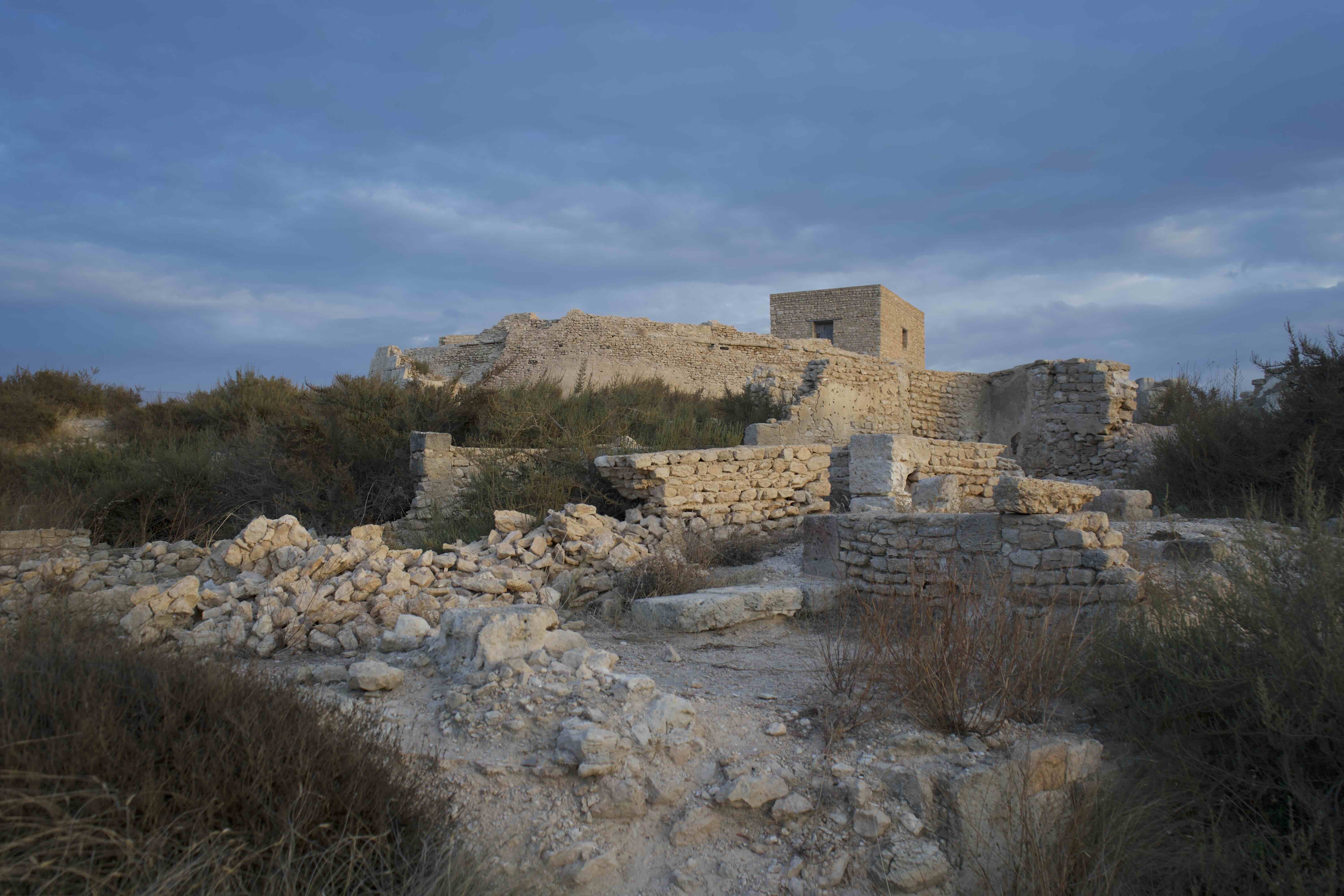
Still, Kerkennah adapts. Retaining walls are built, nurseries tend palms, and heritage practices are being reimagined, blending innovation with care for tradition. These challenges and creative responses were at the heart of a recent climate risk assessment and adaptation planning workshop led by our climate custodians, Sana Taktak and Aissa Arous. Residents from a wide range of backgrounds and expertise—fishers, educators, historians, youth, scientists, and government officials—participated in this multi-day event, building on years of ongoing collaboration between our custodians and the community to explore present impacts, future risks, and community-led solutions.
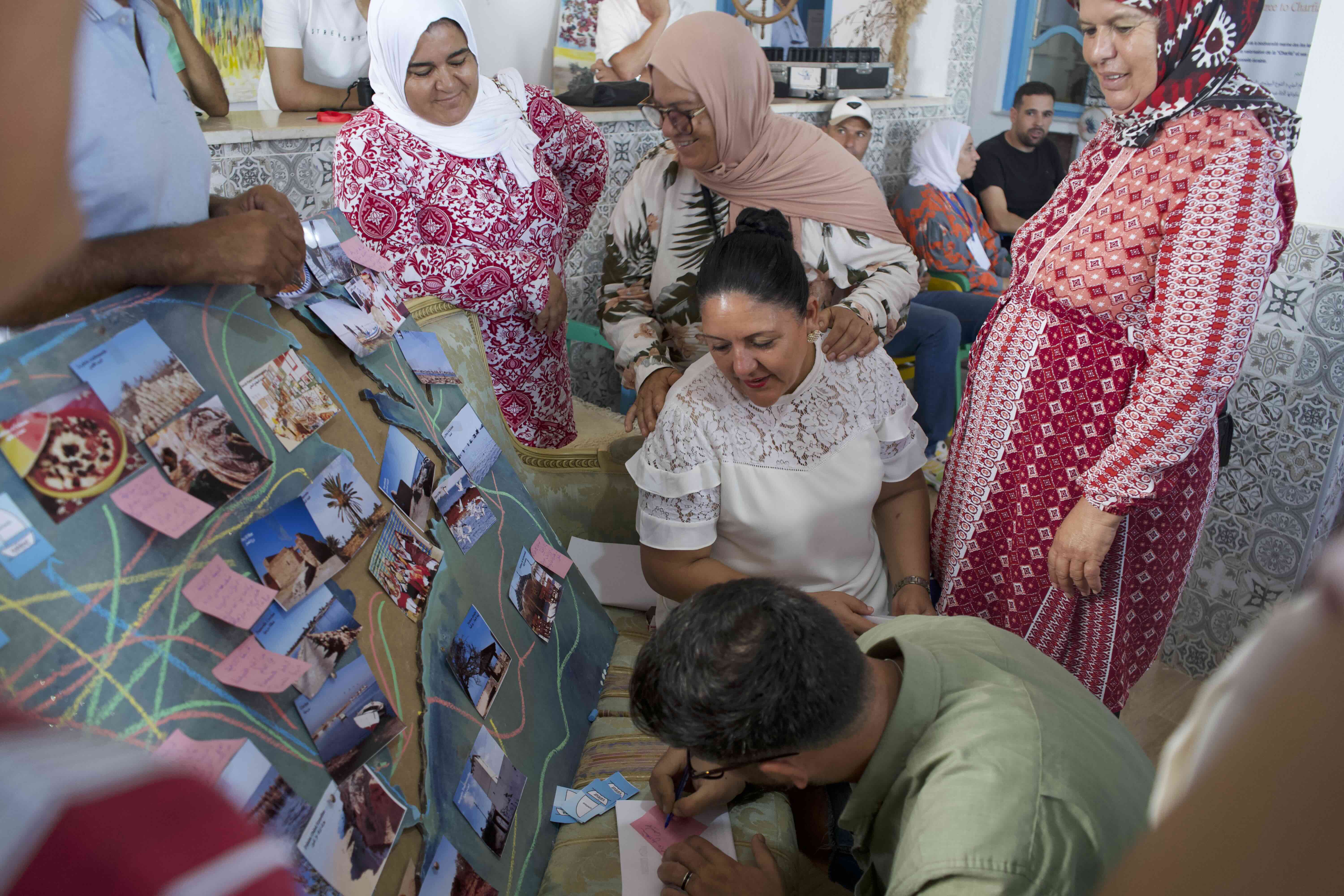
Our organization's staff was honored to join the community throughout the week to support the process and learn from local expertise. Below is a day-by-day journal from our Director of Science, Dr. Salma Sabour, capturing how sessions unfolded, what participants shared, and how knowledge, heritage, and climate science came together to inspire actionable adaptation for Kerkennah’s future:
Day 1 – Exploring Kerkennah’s past, community values, and living heritage to frame present-day climate challenges
Today, Kerkennah’s story came alive through the voices of community, memory, science, and heritage. We began with a welcome from Mr. Tawfik Mostapha of the Ministry of Environment, who spoke about the urgent realities Tunisia faces: groundwater depletion, the spread of new diseases, and villages already lost to the sea. He reminded us how climate change does not impact all places equally, and why updating the national climate strategy is critical.
We then traveled through time with Abdelhamid Fehri and Mr. Souissi (INP), who painted Kerkennah as it once was, a granary for empires, its Borj El Hssar linked to Sfax and far beyond.
The urgency of the present was brought into focus by Hamdi Hached, who shared stark truths: Kerkennah is losing 4 cm of land to the sea each year, two islands have already disappeared, and ancient olive and palm trees are dying from salinization. Looking ahead, projections under pessimistic scenarios (SSP5-8.5) warn that with sea-level rise and extreme events, up to 60% of the island could be inundated, temporarily or permanently.
But the day was not only about loss. Dr. Olfa Saddoud shed light on Kerkennah’s living heritage, specifically its agro-ecosystems. She spoke of the palm groves that anchor the soil and create microclimates, the deep genetic diversity of vines, figs, olives, and dates, and the local knowledge passed down through generations, including techniques such as caprification, drying fruits, crafting charfia weirs, and weaving hats and baskets from palm leaves. She invited us to see Kerkennah not just as vulnerable, but as a model for adaptation and ecological transition, where tradition and biodiversity are the foundation of resilience.

In the afternoon, following the powerful restitution of community values and attributes by Dr. Sana Taktak and Aissa Arous, who had engaged with the community in Kerkennah before the workshop, all participants came together for a collective exercise. Each value and attribute was carefully placed onto beautifully crafted wooden maps of the islands, enriched with colors, photos, and stories, ensuring that the voices of all stakeholders and rights-holders were woven into a holistic picture of heritage and climate realities.
At the Museum of Kerkennah, we walked deeper into Kerkennah’s memory; housed in a traditional island home, daily life, crafts, and rituals of the Kerkennian people came alive, with fishing nets, palm weaving, wedding songs, and even the bones of a whale, each corner holding a fragment of memory and sea. Our next stop was the salt flats, where landscapes once shaped only by rain, sun, and wind now face heavier rains, storms, and shifting weather patterns, which dilute the salt and erode the earthen walls of the marshes and canals.
We closed the day in a circle of music and memory, listening to the moving rhythms of Choghl, Kerkennah’s traditional music, and to stories of how climate change is already leaving its mark on ancestral clothing. It was a reminder that Kerkennah’s future lies in the hands of its people, grounded in memory, culture, and care for the land and sea.
Day 2 – Connecting climate data, local knowledge, and cultural values to understand vulnerabilities across the islands
We opened with a restitution by Dr. Sana Taktak and Aissa Arous, grounding the day in what Kerkennah already lives: sea-level rise and marine erosion nibbling at harbors and heritage on the Kraten–Attaya–Ras Ameur coast; pluvial floods like December 2013, when ~2,500 ha were underwater and low-lying sebkhas held stagnant water for months; salinisation creeping into soils and aquifers; hotter, drier seasons stressing wetlands and groves. Impacts were tied clearly to values:
- 𝑷𝒂𝒍𝒎 𝒈𝒓𝒐𝒗𝒆𝒔, 𝒇𝒊𝒈𝒔, 𝒐𝒍𝒊𝒗𝒆𝒔 (𝑴𝒆𝒍𝒍𝒊𝒕𝒂–𝑺𝒊𝒅𝒊 𝑭𝒐𝒖𝒏𝒌𝒉𝒂𝒍) → root stress from salinity and drought, lower yields, new pests.
- 𝑪𝒉𝒂𝒓𝒇𝒊𝒚𝒂 & 𝒇𝒊𝒔𝒉𝒊𝒏𝒈 → damaged weirs with higher water levels and storms; octopus scarcity reshaping cuisine and income.
- 𝑴𝒂𝒓𝒂𝒃𝒐𝒖𝒕𝒔 & 𝒂𝒓𝒄𝒉𝒂𝒆𝒐𝒍𝒐𝒈𝒊𝒄𝒂𝒍 𝒔𝒊𝒕𝒆𝒔 (𝒆.𝒈., 𝑩𝒐𝒓𝒋 𝑬𝒍 𝑯𝒔𝒔𝒂𝒓) → shoreline retreat and spray weathering, risk of submersion.
- 𝑷𝒐𝒓𝒕𝒔 & 𝒄𝒐𝒂𝒔𝒕𝒂𝒍 𝒏𝒆𝒊𝒈𝒉𝒃𝒐𝒓𝒉𝒐𝒐𝒅𝒔 (𝑲𝒓𝒂𝒕𝒆𝒏, 𝑬𝒏𝒏𝒂𝒋𝒆𝒕, 𝑨𝒕𝒕𝒂𝒚𝒂, 𝑹𝒂𝒎𝒍𝒂, 𝑶𝒖𝒍𝒆𝒅 𝑲𝒂𝒄𝒆𝒎, 𝑶𝒖𝒍𝒆𝒅 𝒀𝒂𝒏𝒆𝒈) → repeated flooding where altitude is <1 m.
- 𝑾𝒆𝒕𝒍𝒂𝒏𝒅𝒔/𝒔𝒆𝒃𝒌𝒉𝒂𝒔 → expanding since the 1960s (≈+480 ha), altering habitat and flood pathways.
- 𝒊𝒐𝒅𝒊𝒗𝒆𝒓𝒔𝒊𝒕𝒚 & 𝒔𝒆𝒂𝒃𝒊𝒓𝒅𝒔 → declines, alongside new invasive species in warming waters.
A plenary discussion followed, then small workgroups gathered around the wooden maps to re-check and complement the present impacts mapping: rafts that depend on seasonal plants are faltering. The famed couscous with octopus is harder to serve in season, and with that, a steady trickle of culinary tourism fades. Charfiya installations are more costly to maintain and more vulnerable to waves. Marabouts and archaeological sites are vulnerable to erosion; sandstone faces weathering more quickly in salt-laden winds. People associate place with value in terms of its present impacts and risks, including the everyday: higher summer heat, fewer cool nights, erratic rains that come heavy and fast, fields that don’t drain, and roads that act like dams across the sebkhas.
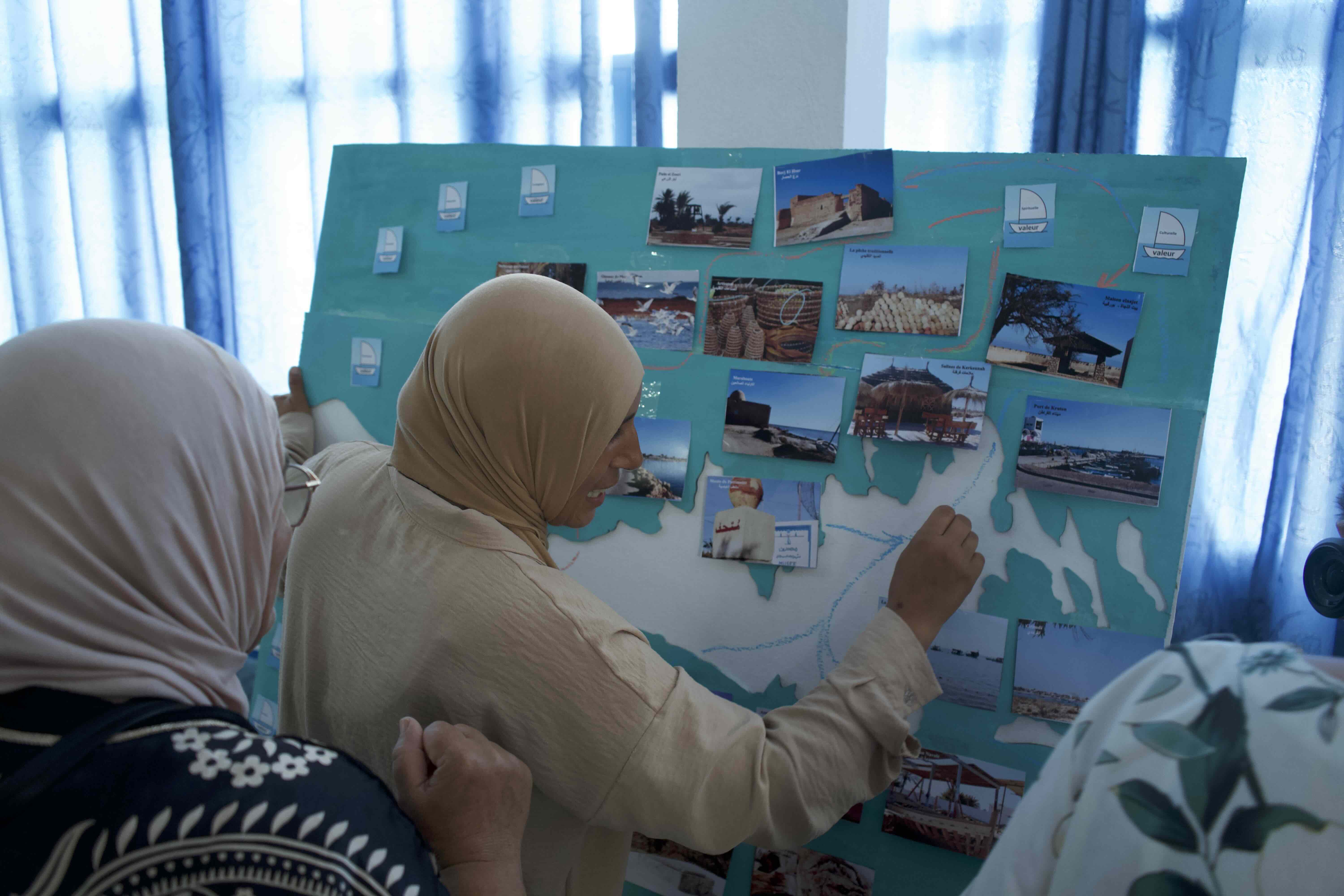
In the afternoon, two expert inputs sharpened the lens. Dr. Riadh Bouaziz examined the dynamics of flooding and inundation under rising sea levels, exploring how sebkhas, historical flood patterns, and contemporary coastal management practices interact to change flooding patterns. Later, Dr. Moncef Sarbeji showed how GIS can knit together what we mapped today with land use, elevation, hydrology, and heritage layers to guide choices: where to retreat, where to reinforce, where to restore flows across sebkhas so floods spread safely, where to prioritize charfiya zones, palm groves, marabouts, and coastal roads.
A lively debate filled the room as we delved into how to interpret projections (SSP2-4.5, SSP5-8.5), what uncertainty ranges mean for real-world decisions, and how to prevent figures from being taken out of context. The conversation pushed forward: 𝑾𝒉𝒂𝒕 𝒅𝒐 𝒕𝒉𝒆𝒔𝒆 𝒇𝒖𝒕𝒖𝒓𝒆𝒔 𝒎𝒆𝒂𝒏 𝒉𝒆𝒓𝒆, 𝒐𝒏 𝒕𝒉𝒆𝒔𝒆 𝒊𝒔𝒍𝒂𝒏𝒅𝒔? 𝑯𝒐𝒘 𝒅𝒐 𝒘𝒆 𝒔𝒑𝒆𝒂𝒌 𝒂𝒃𝒐𝒖𝒕 𝒖𝒏𝒄𝒆𝒓𝒕𝒂𝒊𝒏𝒕𝒚 𝒘𝒊𝒕𝒉𝒐𝒖𝒕 𝒇𝒖𝒆𝒍𝒊𝒏𝒈 𝒇𝒆𝒂𝒓? 𝑯𝒐𝒘 𝒅𝒐 𝒘𝒆 𝒌𝒆𝒆𝒑 𝒕𝒉𝒆 𝒏𝒖𝒎𝒃𝒆𝒓𝒔 𝒂𝒏𝒄𝒉𝒐𝒓𝒆𝒅 𝒊𝒏 𝒍𝒊𝒗𝒆𝒅 𝒓𝒆𝒂𝒍𝒊𝒕𝒊𝒆𝒔 𝒐𝒇 𝒄𝒐𝒎𝒎𝒖𝒏𝒊𝒕𝒊𝒆𝒔?
Kerkennah’s adaptation path is clear: knowledge must be plural, tools must be open, data must be understood and appropriated, and action must be led from within. Today, we held evidence and experience side by side with care and compassion. Tomorrow, we keep weaving that path together, from present impacts to future risk and climate action.
Day 3 – Hands-on learning on the flouka, observing fisheries, marabouts, and traditional practices in action
We set out early in the morning on a flouka with local fishers, guided by Youssef Farhat and Nader Ben Hadj Hmida. The horizon opened wide, nets and wooden, plastic, and iron poles marking the charfiya traps that have long defined Kerkennah’s seascape. Stories surfaced of how these fisheries are changing:
- 𝑻𝒓𝒂𝒅𝒊𝒕𝒊𝒐𝒏𝒂𝒍 𝒄𝒉𝒂𝒓𝒇𝒊𝒚𝒂: once built with palm trunks and fronds, flexible and biodegradable, but now increasingly replaced with plastic pipes or iron tubes as palm becomes scarce and costly.
- 𝑭𝒊𝒔𝒉 𝒔𝒑𝒆𝒄𝒊𝒆𝒔: invasive arrivals in warming waters compete with native stocks, while octopus and other staples are harder to find.
- 𝑲𝒏𝒐𝒘𝒍𝒆𝒅𝒈𝒆: intergenerational skills of reading tides, placing traps, and timing harvests are eroding as livelihoods shift and younger generations leave the archipelago.
On the boat, the rhythm and music reminded us that across ten countries represented here, we shared a single vessel, sensing the sea’s strength, fragility, and generosity. Climate change, while a threat, has also become an opportunity for reconnection: to listen, to learn, and to embody the lived experience of damage, loss, and resilience.

In the afternoon, the journey turned landward. At Attaya, we walked toward the marabout of Sidi Massʿoud. A folkloric performance, “Dakhlet Sidi Massoud,” animated the visit. Drums, chants, and dance carried the festival’s spirit, echoing generations who have honored the marabout. Children, elders, and guests walked side by side, weaving memories, music, and a sense of belonging to the place. Later, we visited the coastal zones with the Agency for Coastal Protection and Planning (APAL) and the communities, where erosion, waste, and shifting shorelines highlighted the fragility of the interface between land and sea.
We witnessed a stark lesson in maladaptation: a dike intended to block seawater now traps rainwater in the sebkha, intensifying floods, disrupting landscapes, and breaking fishers’ ties to the sea. The root causes were clear: poor communication between agencies and the insufficient (but existing) community involvement. We were reminded that adaptation must be participatory, careful, and co-created; otherwise, it risks amplifying the very losses it seeks to prevent.
As the sun dipped behind the horizon, we stood on the Attaya footbridge, watching light fade to gold over the sea. The day’s threads were clear:
- 𝑪𝒉𝒂𝒓𝒇𝒊𝒚𝒂 𝒏𝒆𝒕𝒔: resilience under strain; traditional fishing techniques adapting to change, yet constrained by the rising cost and declining availability of palm materials.
- 𝑺𝒆𝒃𝒌𝒉𝒂𝒔: fragile ecologies; wetlands further destabilized by maladaptive infrastructure, showing how human interventions can amplify natural vulnerabilities.
- 𝑴𝒂𝒓𝒂𝒃𝒐𝒖𝒕 𝒐𝒇 𝑺𝒊𝒅𝒊 𝑴𝒂𝒔𝒔𝒐𝒖𝒅: heritage as anchor; at risk from climate change and neglect, yet still carrying faith, memory, and celebration, binding communities to place.
Kerkennah’s lessons resonate: adaptation needs to be both technical and cultural. It is built on the choices of nets, the shape of dikes, the persistence of festivals, and the ways communities keep faith with land and sea. Here, knowledge and embodiment come together, reminding us that resilience grows strongest when rooted in people, place, and shared care.
Day 4 – Engaging youth, elders, and artisans to explore solutions through storytelling, crafts, and play
We began at El Kantara and Sidi Fraj, standing on one of Kerkennah’s most eroded coastlines. Protected and unprotected stretches lie side by side, depending on whether projects are funded by the Ministry of Equipment or by the Ministry of Environment with international support. The sea is advancing relentlessly: nibbling at harbors, neighborhoods, and heritage. At the Falaise of Ouled Ezzeddine, erosion was carving the cliffs, and sandstone faces were weathering faster under the salt spray and waves.
At the Maison de Jamila, fisher and farmer women welcomed us with a traditional pause and shared irrigation practices that have long supported palms and groves through dry seasons. Olive trees now ripen too early, sometimes as soon as November, cutting short oil accumulation and lowering yields. Their leaves curl tight to conserve water, a survival strategy that slows photosynthesis.
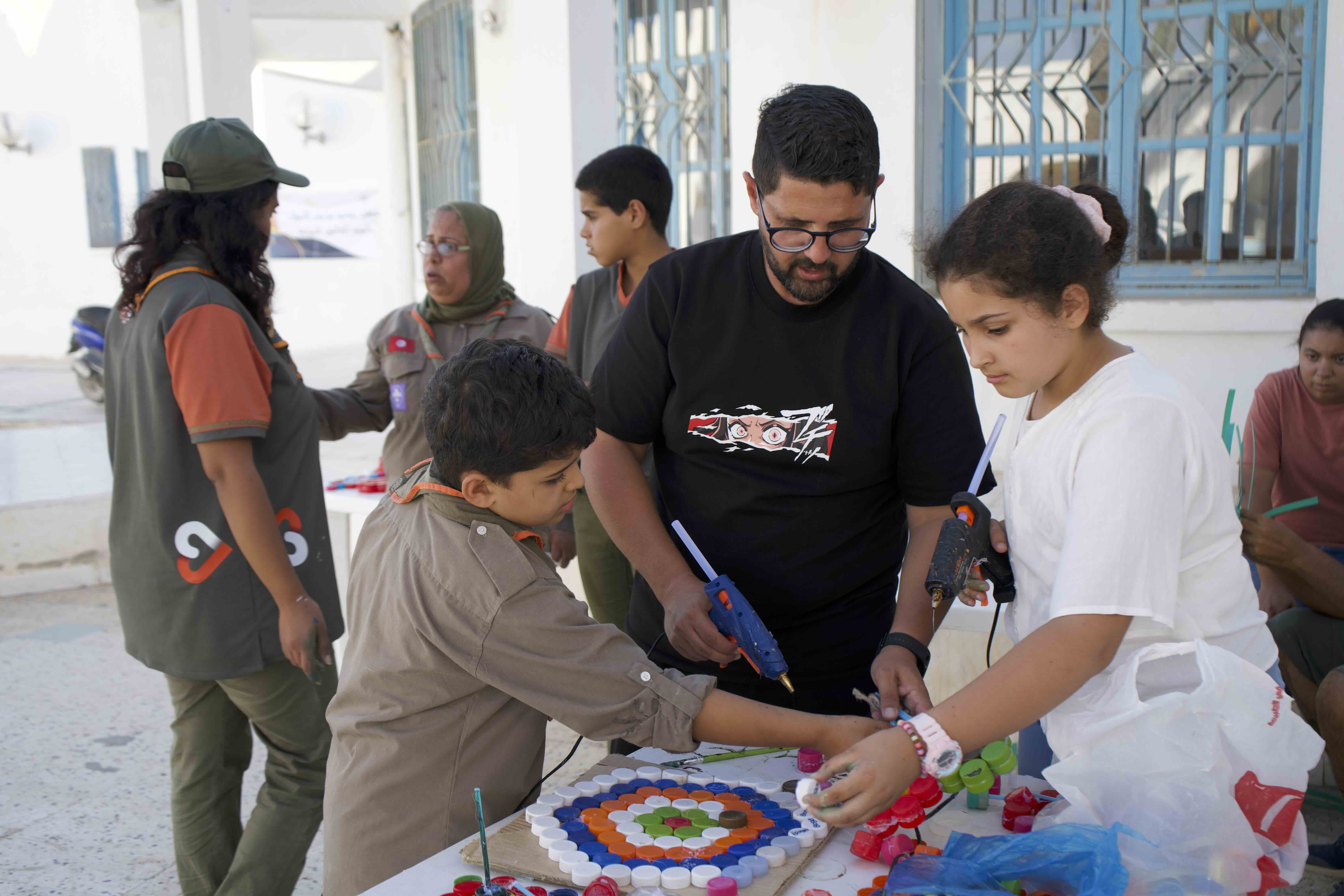
The afternoon unfolded at the youth centre, where intergenerational exchange anchored the day in memory and adaptation. We began with reflections on lost zerbias: once water-holding landscapes, now remembered only by painted traces on the ground. Plastic pollution has been identified as a new threat. Children learned to weave Charfiya nets, inheriting skills that tie identity, livelihood, and sustainability together. A miniature of Borj El Hsar was inaugurated as an adaptation action, reminding youth of heritage at risk and planting responsibility for its future.
We then watched five short films made by local youth, each a creative lens on the intersections of climate change and heritage in Kerkennag. They carried urgency and imagination, showing how the next generation sees both risk and adaptation possibilities.
Later, the community joined a scenario workshop, exploring middle-of-the-road (SSP2–4.5) and pessimistic (SSP5–8.5) climate futures for Kerkennah. Around maps and stories, people traced how impacts might unfold across heritage places and systems: what could be lost, what might adapt, and where choices still remain.
The day closed with a creative game on climate risks, impacts, and adaptation, built on Kerkennah’s heritage attributes and values, developed by Sana Taktak, Aissa Arous, and the incredible Acg Generations team. Through play, conversation, and knowledge-sharing, generations came together to imagine futures, explore solutions, and practice resilience.
Day 5 – Synthesizing lessons into concrete adaptation strategies, nature-based solutions, heritage protection, and governance initiatives
We began in Kraten, stepping into the world of marine conservation at the research center led by Ahmed Soussi (AKDDCL - Association Kraten du développement durable de la culture et du loisir AKDDCL). The morning carried us into the waters of the Marine Protected Area: 187 km² wide, dotted with twelve untouched islets, where vegetation clings to the salt air and migratory birds descend each winter and spring. The AKDDCL focus is on three species that hold Kerkennah’s ecological value:
- 𝑷𝒐𝒔𝒊𝒅𝒐𝒏𝒊𝒂, meadows of seagrass that breathe oxygen into the sea, anchor sand, shelter nurseries of fish, and store carbon in their roots.
- 𝑷𝒊𝒏𝒏𝒂 𝒏𝒐𝒃𝒊𝒍𝒊𝒔, the noble pen shell, rising silently from the seabed, a fragile sentinel of water quality, now critically endangered.
- 𝑶𝒄𝒕𝒐𝒑𝒖𝒔 𝒗𝒖𝒍𝒈𝒂𝒓𝒊𝒔, once abundant in Kerkennah’s traps and kitchens, now scarcer each year, its absence as telling as its presence.

The dialogue with the fishers was constant. They spoke of illegal trawling that scars the seabed, of shifting catches, and of their role in protecting turtles and seabirds. They are fishers, yes, but also observers, monitors, and even biologists, encouraged to join researchers in collecting samples, reporting changes, and leading with their knowledge in science. Slowly, the figure of the fisher-biologist emerges, rebuilding the bridge between science and community, reminding us that science has always been woven into local livelihoods since the dawn of civilisation.
By afternoon, we gathered in Hotel Nakhla, where the room was filled with maps, voices, and determination. This marked the beginning of adaptation action planning for the most important heritage attributes in Kerkennah. Together, the community drew out actions, rooted in memory, tied to values, and oriented toward Kerkennah’s different potential futures:
𝑵𝒂𝒕𝒖𝒓𝒆-𝒃𝒂𝒔𝒆𝒅 𝑺𝒐𝒍𝒖𝒕𝒊𝒐𝒏𝒔: Kerkennah’s adaptation begins with nature itself. Protecting Posidonia meadows, planting cactus and Lektaf barriers, and conserving Roman stone reefs all help slow the advance of the sea. Drainage networks can channel rainwater, reducing stagnant floods in sebkhas. Palm groves remain central: nurseries expand Kerkennah’s own hardy palms while testing other species, such as carob, for resilience. The survival of the palm, however, depends on water and soil quality, as rising heat above 35–40°C threatens its future. These actions safeguard seascapes, groves, bird habitats, and wetlands, guided by the values of ecological balance, interdependence between land and sea, and care for future generations.
𝑪𝒖𝒍𝒕𝒖𝒓𝒂𝒍 & 𝑯𝒆𝒓𝒊𝒕𝒂𝒈𝒆 𝑪𝒐𝒏𝒕𝒊𝒏𝒖𝒊𝒕𝒚: Octopus fishing traditions embody both knowledge and identity. Palm-leaf traps, rock shelters, and seasonal respect for the life cycle of octopus — once taught by mothers and grandmothers — can be revived and protected in law. These practices tie the octopus not only to cuisine but also to memory, storytelling, and women’s traditions. Boatbuilding remains a living craft, to be preserved and taught with the same care as embroidery or metalwork. Folklore, too, links sea and art: fishermen turn artists in summer festivals, where music, dance, and craft weave identity into celebration. Restoring marabouts and sacred places, such as Sidi Massoud, ties spirituality and devotion to adaptation, ensuring the continuity of memory and pride in craftsmanship.
𝑮𝒐𝒗𝒆𝒓𝒏𝒂𝒏𝒄𝒆 & 𝑱𝒖𝒔𝒕𝒊𝒄𝒆: Adaptation demands fairness. Insurance schemes for fishers, similar to those protecting farmers, can buffer losses when turtles damage nets or stocks decline. Stronger community voices in decision-making, through assemblies and participatory processes, ensure that local realities guide national frameworks. Regulations on octopus fishing seasons, net sizes, and destructive trawling protect resources while honoring traditional knowledge. Restoration of monuments requires national institutions to invest directly, not leaving the burden to local communities alone. These pathways embody values of solidarity, fairness, accountability, and shared stewardship between people and institutions.
- 𝑳𝒊𝒗𝒆𝒍𝒊𝒉𝒐𝒐𝒅𝒔 & 𝑳𝒐𝒄𝒂𝒍 𝑬𝒄𝒐𝒏𝒐𝒎𝒚: Diversifying livelihoods strengthens resilience. Crafts and folklore can be supported as viable incomes through festivals, markets, and innovative designs. Fishermen’s artistry, in the form of nets, traps, boats, and songs, can be recognized as both a heritage and an economic asset. Education and apprenticeships ensure skills are passed to youth, keeping traditions alive while creating new opportunities. Clothing and crafts can adapt to shifting climates, just as festivals and performances adapt to new audiences. These actions uphold values of dignity in work, creativity, resilience through diversification, and joy in celebration.
The day culminated with the signature of the adaptation charter by all local communities present. Each name inscribed was a commitment, a shared promise to safeguard the sea, the palms, the heritage, and the generations to come.
As the day waned, images of hope emerged: children learning to see turtles as kin; palms sprouting in new nurseries; the sound of hammers on wood as young carpenters shape boats; communities gathered hand in hand around a charter for their future. Together, they form a narrative of fragility and resilience, renewal, creativity, and care, a weaving of lives, species, and futures, fragile, yes, but also fiercely alive with hope.
We offer our heartfelt gratitude to our climate custodians, Sana Taktak and Aissa Arous, whose lifelong dedication and unwavering commitment to their community made this workshop—and its outcomes—possible. Their generosity and guidance continue to light the path toward a resilient future for Kerkennah’s vibrant heritage and we can't wait to support their journey into action.
